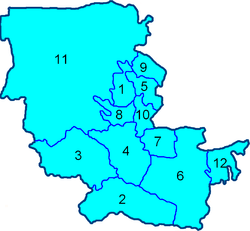Jizzakh Region
Jizzakh Region (Uzbek: Jizzax viloyati, Жиззах вилояти, جىززﻩخ ۋىلايەتى) is one of the regions of Uzbekistan. It is located in the center/east of the country. It borders with Tajikistan to the south and south-east, Samarqand Region to the west, Navoiy Region to the north-west, Kazakhstan to the north, and Sirdaryo Region to the east. It covers an area of 20,500 km². The population is estimated to be around 910,500, with some 80% living in rural areas.
Jizzakh Region Jizzax viloyati | |
|---|---|
Region | |
 Jizzakh in Uzbekistan | |
| Coordinates: 40°25′N 67°40′E | |
| Country | Uzbekistan |
| Capital | Jizzakh |
| Government | |
| • Hokim | Ergash Saliev |
| Area | |
| • Total | 21,179 km2 (8,177 sq mi) |
| Elevation | 274 m (899 ft) |
| Population (2017) | |
| • Total | 1,301,000 |
| • Density | 61/km2 (160/sq mi) |
| Time zone | UTC+5 (East) |
| • Summer (DST) | UTC+5 (not observed) |
| ISO 3166 code | UZ-JI |
| Districts | 12 |
| Cities | 7 |
| Townships | 8 |
| Villages | 95 |
| Website | www |
The regional capital is Jizzakh (pop est 127,500 inhabitants). Other major towns include Dustlik, Gagarin, Gallyaaral (Gallaorol), Pakhtakor, and Mardjanbulak. Jizzakh Region was formerly a part of Sirdaryo Region but was given separate status in 1973.
The climate is a typically continental climate, with mild winters and hot, dry summers.
The economy of Jizzakh Region is primarily based on agriculture. Cotton and wheat are the main crops, and extensive irrigation is used. Natural resources include lead, zinc, iron, and limestone. Uzbekistan and China are working together to jointly establish a Special Economic Zone in the region. This high-tech industrial park will be formally established by March 2013. The China Development Bank will provide a $50 million loan to finance several of the joint projects in the construction, agro-industrial and mechanical engineering sectors.[1]
The region has a well-developed transportation infrastructure, with over 2500 km of surfaced roads.
The Zaamin National Park, formerly Guralash Preserve, on the western slopes of the Turkestan Range and known for its unique fauna and flora, is also within the region.
Wildlife is extremely rich here; in spring and in summer, alpine meadows are with a multitude of colors: bright-red tulips and snow-white acacias. In autumn the hills are magnificently decorated with the gold-colored domes of the hazelnut trees, columns of birch-trees, towering plane trees, and green thickets. High in the mountains, in the upper part of the Garalashsay gorge, is a nesting-place of black storks. These rare birds are the pride and joy of Uzbekistan. They are written down in the "Redbooks" in many countries as an endangered species. Early in the spring when the Amasay depression is flooded, flocks of ducks, wild geese, pelicans and grey herons are found here. This territory serves as a nesting place for rose-coloured starlings, shrikes, and sandpipers.
Districts

The region is divided into 12 districts (tumans):
| Key | District name | District capital |
|---|---|---|
| 1 | Arnasay District | Goliblar |
| 2 | Bakhmal District | Usmat |
| 3 | Dustlik District | Dustlik |
| 4 | Forish District | Yangikishlok |
| 5 | Gallaorol District | Gallaorol |
| 6 | Sharof Rashidov District | Uchtepa |
| 7 | Mirzachul District | Gagarin |
| 8 | Pakhtakor District | Pakhtakor |
| 9 | Yangiabad District | Balandchakir |
| 10 | Zaamin District | Zaamin |
| 11 | Zafarobod District | Zafarobod |
| 12 | Zarbdar District | Zarbdar |
Gallaorol District (also spelled Gallyaaral) is the largest district in Jizzakh Region with 1,959 km2 and 130,000 people. This district borders with Jizzakh, Bakhmal, and Forish districts of Jizzakh Region and with Buklungur, Jomboy, and Kushrabot districts of Samarqand Region to the west. The district was called Yangikurgon until September 1926. Its current name Gallaorol derives from "Galla" – wheat and "Orol" – island. A leading politician of Uzbek SSR on a visit to this district said that wheat fields looked like islands, after which the name was officially changed. The district is one of the important industrial centers in Uzbekistan.
The town of Gallaorol (Gallyaaral) is the district capital. Founded in 1898-1899 as a railway depot on the Silk Road, Gallaorol became a town in March 1972 and today it spans an area of 34.3 km2 with a population of 28,519.
References
- "Uzbekistan, China to Develop Special Economic Zone in Jizzakh". The Gazette of Central Asia. Satrapia. 26 January 2013.
External links
- Jizzakh Region official web site (browse through all accessible sections).